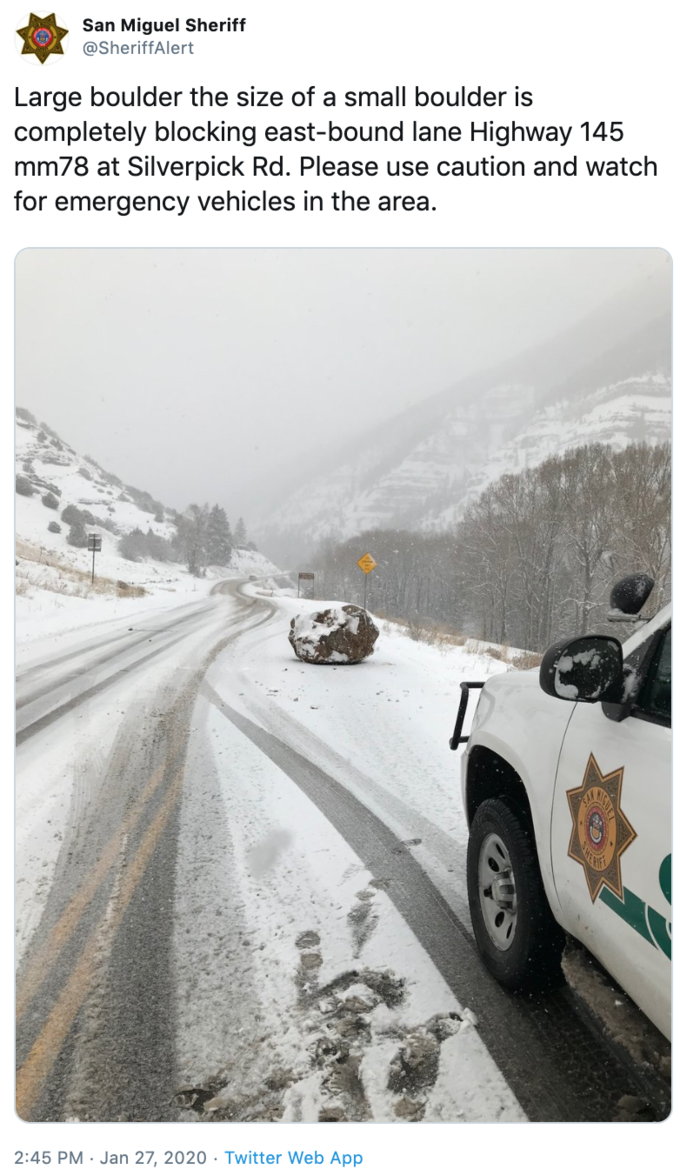
why doesn’t someone just push it out of the way?
Or… punch it?
Chris Redfield is busy somewhere else
It’s the police, they’ll just shoot it out of the way.
Only if it black
Why push it, just ride it like the pioneers used to do.
Looks like something you can manipulate with a sheikah slate
According to google, a deer has a height between 0.85 to 1.5 metres. According to the Texas Almanac, the Lone Star State extends 801 straight-line miles (from north to south). This equates to 1289084,54 metres.
Taking this into account, a deer is between 0,00000066 and 0,0000012 Texas.
I hope this helps.
But how many square burgers is that?
Sir, this isn’t Wendy’s.
Good catch!
I know, I’m just here for the Brawndo. It’s got electrolytes!
Great question!! Ok a rough estimate is the best I can do. As everything is bigger in Texas, I will take a relatively big deer for reference. As you will understand, I must compare area with area, so here goes:
Taking a BigMac as a reference and assuming a patty diameter of 10.4cm Source. This would lead to an area of 84.95cm2.
A bigger deer skin could be 150x139 cm Source. On the one hand this is an overestimation because those are the maximum measures and it’s not perfectly square, but on the other hand we’re not taking certain area’s such as the hooves and head into account. The area comes to 20850cm2.
So one deer is, in terms of area, as big as 245,4 hamburgers.
Again, I hope this helps.
I assume you’re still measuring in Texas Deer units…
Yes, very helpful!
Somewhere between 746 and nineteen quintillion. Hope that helps.
Are we talking 1/4lb, 1/3lb, or 1/2lb? Then are we talking single, double, triple? Hamburgers as a unit of measurement is a horrible idea.
A hamburger weighs as much as 3 bananas, everyone knows that silly.
I stand corrected. A banana weighs as much as 3 hamburgers.
We don’t have this one around here, but we have one about half of its (linear) size, so 1/8 of the weight. It already weights more than 3 hamburgers (unless they are like the one on the photo around the comments here).
Bananas are quite dense.
Say what you will about the American education system, but I know it’s a 1/4 lb burgers because you could get close(ish) to 200 lbs of meat from a deer if you were lucky in Oregon Trail.
I need a conversion to cheeseburgers. I rarely work with regular hamburgers.
Hamburger units feel appropriate for things that can be hamburgers.
But that includes organs and stuff so they also need to tell us how many hotdogs. I weigh 783 hamburgers and 132 hotdogs
You forgot to add in the 15% sawdust…
What’s the convention rate from hamburger to American frie’s?
3 bags of five guys fries per burger.
So you’re telling me that deer are made out of hamburgers and bicycles?
The person who wrote this is on a bicycle to work off the 800 burgers made from deer.
That’s excellent deduction, Watson.
1 centiyard is about equal to 1 centimeter
1 miliyard is 3 milifeet
1 kiloyard is 3 kilofeet
It would be the same as the metic system having something like a “hand”
That if you wanted to express 1/3 of a meter you could just call it 1 hand. 2/3 meter would be 2 hands.
If you were using this metric system and knew that something had to be two hands long. You’d simply call it 2 hands instead of .66 meters or 66 centimeters.
If something had to be 2.5 hands long it would be .825 meters or 82.5 centimeters
Meter and yard are both random established lengths. Using miliyards or millimeters is exactly the same.
US customary units just have smaller unit names you can call them if it is convenient. If you never wanted to use anything but yards like the metric system does meters, it’s possible. Don’t want to use miles? Then megayards.
I do think 1 simple system that everyone uses is needed and the metric system is simple.
But if stupid Americans can use the “difficult” system, it can’t be too hard.
But if stupid Americans can use the “difficult” system, it can’t be too hard.
I think about this whenever I see someone complain about how Fahrenheit is arbitrary and how are you supposed to remember that water freezes at 32° and boils at 212°. I guess American brains are just able to retain more.
You never deal with 0°C/32°F or 100°C/212°F unless you’re in a science lab.
They are nice numbers in celcius, but for real-world applications, it’s almost meaningless.
When I boil water on the stove, I don’t check if it hits 100°C. When I freeze water in the freezer, I don’t check if it hits 0°C.
Everyone can get by without knowing the exact degrees.
This is pure water at standard pressure. Higher or lower altitudes will change it, and if your water has minerals or impurities in it, it will also change it. It’s pretty arbitrary.
Water on roads can freeze before it hits 0°C outside. It can even snow above 0°C.
Fahrenheit is a very simple scale other than those two things. <0° extremely cold, >100° extremely hot for air temperature. Freezers are 0°F and Saunas are 200°F. Hot tubs are 100°F. You bake cookies at 325° to 375°, pizza is cooked at 600° to 800°F. You’ll find a lot of 25° increments in cooking.
Fahrenheit isn’t really a part of the US customary units.
Knowing both Fahrenheit and Celsius, I do think Fahrenheit is simpler for real-world applications. For science they are just numbers on a scale. Converting is the only real problem.
Trying to learn Fahrenheit scale isn’t that easy as an adult. I know 0 is very cold and 100 very warm. So of course it follows 50 is perfect weather. Turns out it’s not.
In the end you still just have to learn by hearth that t-shirt weather starts at 70 something and that kind of stuff.
50°F is the point where you need clothes to survive. If you sat naked in a 50°F room you run the risk of your body not being able to generate enough heat and you’ll slowly die.
~75°F is room temperature. It’s in the middle on the warm side.
70°F is a cool room, 80°F is a warm room.
Whenever I think of Celsius I see it as 0° to 40° with 20° being room temperature. I hear 30°C and think halfway between 70 and 100 so I know it’s around 85°F and I know how 85°F feels.
But like 35°C. That’s 3/4 of the way from 20°C to 40°F. 100°F-70°F is 30°. 3/4 of 30 is 22.5. So 35° must be close to 70°+22.5° or ~93°F. I know how 93°F feels.
I can see how celcius is easier if you learned it as a child. 35°C would just be 35°C. But trying to quickly wrap your head around it is difficult unless you just know it. I’m sure if I said 93°F you could tell me that that is pretty hot.
75F would already be a warm room for many. 70F or 21C is usually room temperature around here. In the past this was often 65F. In more southern places 75F is middle of the night temperature and too cold.
I can see how the F scale makes some sense, but then you see some news report from Texas reaching 100F and you wonder if people can read their own temperature scale as that is clearly not fit for human habitation.
deleted by creator
There are the “I like to keep my house at 66°F because I like to wear a hoodie or use a blanket”. They are going to say that 75°F is warm or even hot for a room.
If an average person sat naked in a 75°F room they would be happy.
68°F or 20°C is cold for me. Even 70°F or 21°C. I keep my house around 72° to 74°F and bump it up or down a degree. Coming in from mowing the yard, bump it down, sitting all day watching movies, keep it the same, cold winter day, bump it up.
Older people keep their houses at 78°+
100°F doesn’t mean “not fit for human habitation”
Anything above body temperature of 98.6°F (37°C) you are slowly cooking yourself. That’s why 100°F is important.
I just feel the need to say the yard and meter weren’t randomly established distances. They were chosen. Meter being the earth’s circumference divided by 40 million (or rather the distance from the pole to the equator divided by 10 million). Useful for map making and navigating.
And the yard being the distance from the nose to the thumb of some British monarch, Henry I, I think. Useful for buildings and making sure things are within reach for the average person
Fun facts:
1 Mile Per Hour ≈ 2.511 Bananas Per Second
1 Kilometer Per Hour ≈ 1.561 Bananas Per Second
Calculated with the assistance of http://bananaforscale.info/
Keeping it at seconds still makes it relatively comfortable for me. Bananas per minute (BPM) is where it’s at
1 Mile Per Hour ≈ 150.688 Bananas Per Minute
1 Kilometer Per Hour ≈ 93.633 Bananas Per Minute
That’s how you know that Americans hate even their own imperial system. As an American myself, I gotta ask, is it the weight of a Cheeseburger or the Big Mac?
A Big Mac is ~250g, a cheeseburger ~120g.
An American male mule deer is 95 - 150kg.
So to answer your question, they’re using something closer in size to the cheeseburger and not the Big Mac, as 800 Big Macs is about ~190kg whereas 800 cheezburgers is about 96kg.
I’m willing to defend the use of US Customary.
Come at me, bitches.
Stand at my back! We will fight them off together!
Tradesman? Skilled labor? Common day vikings!
But stand at least 3 burritos away plz.
I want this on a T-shirt.
How do Americans find out how big a bicycle is?
Oh, you know. We see them at schools, on the news…
Some of us steal them.
Average ballsack height.
Well going by that measurement, the ladies are gonna have an ahem, interesting ride…
Fair point. If we’re talking top of the sack I’m 5’10". Bottom? 3’.
You might have noticed. It’s kind of our thing, doing things differently from the rest of the world for no good reason.
Different measuring system
Different cars
Different health care system
Different social ethics
Different system of government
Very few trains
We’re just a bunch of silly dumbasses here.
I mean there is a good reason… And that reason is, which I will state in this comment, is that the reason is very good in terms of the fact that hereby unto forthwith hence that reason is valid.
So what you’re saying is, I can make 800 venison hamburgers from a single deer? Nice.
If you like eating every single piece, guts, brains, bones and all, sure go for it 👍
Hey if you grind the bone fine enough you can’t tell and it is a great source of calcium.
Did you just invent Deer Jello?
No that is when you boil the gelatin out of the joints. Then combine it with some blood and put it in the fridge to set. I like to use my deer shape ice cube tray.
deleted by creator










